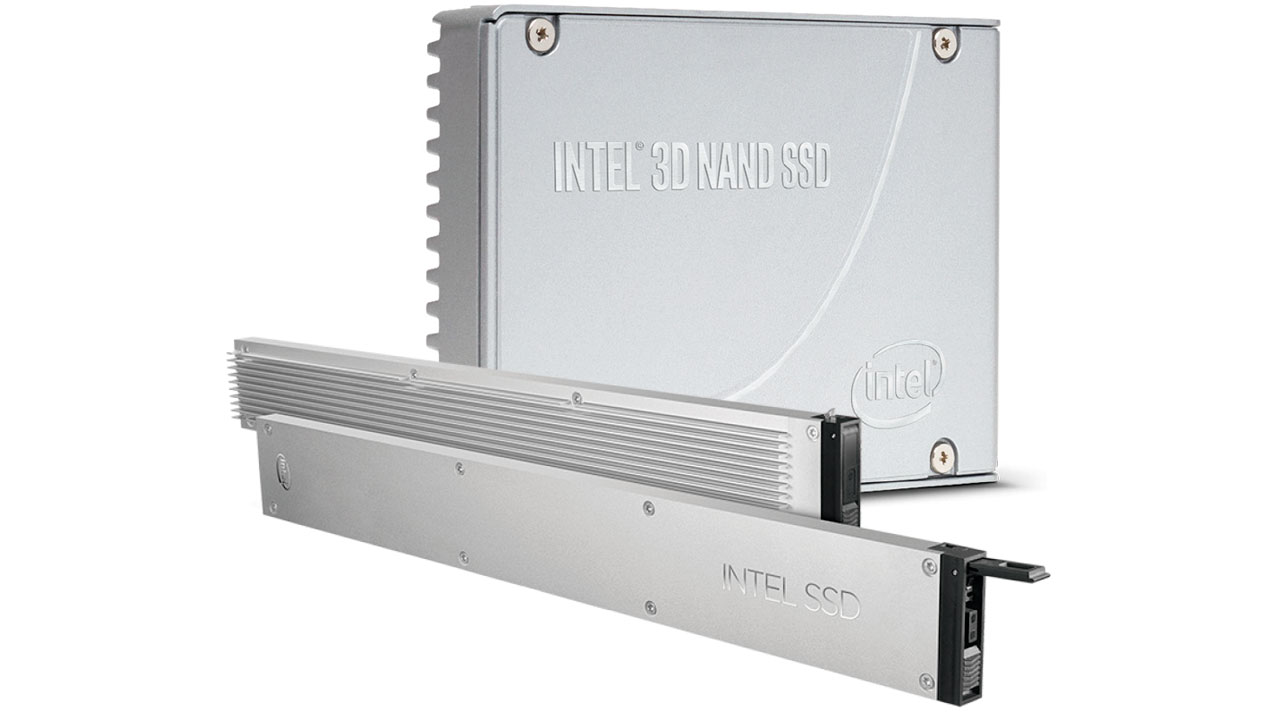Intel Quietly Launches 15.3TB Ruler SSDs
Apparently, Intel has added two new drives to its DC P4510 SSD family. The new SSDs adhere to the Enterprise & Data Center SSD Form Factor (EDSFF), casually called the ruler form factor.
The EDSFF-based DC P4510 SSDs respect the E1.L standard and are available with 9.5mm or 18mm heatsinks. They slide vertically into a 1U enclosure and communicates via a standard PCIe 3.1 x4 interface.
The whole point of the EDSFF presentation is to maximize the storage capacity per SSD in a 1U server unit, and Intel has done just that. The original DC P4510 that comes in U.2 form factor maxes out at 8TB. With EDSFF, Intel has almost doubled the capacity up to 15.3TB.
Internally, the EDSFF drives are still using Intel and Micron's 64-layer 3D TLC (triple-level cell) NAND chips. Intel hasn't specified the name or model of the controller. However, they should be leveraging the same second-generation Intel NVMe SSD controller present in the U.2 offerings.
Intel DC P4510 SSD Specifications
| Capacity | Form Factor | Lithography | Sequential Read (MBps) | Sequential Write (MBps) | Random Read (IOPS) | Random Write (IOPS) | Endurance (PBW) | Warranty |
|---|---|---|---|---|---|---|---|---|
| 15.3TB | E1.L | 64-Layer TLC 3D NAND | 3,100 | 3,100 | 583,800 | 131,400 | 22.7 | 5 years |
| 15.3TB | E1.L | 64-Layer TLC 3D NAND | 3,100 | 3,100 | 583,800 | 131,400 | 22.7 | 5 years |
| 8TB | U.2 15mm | 64-Layer TLC 3D NAND | 3,200 | 3,000 | 641,800 | 134,500 | 13.88 | 5 years |
| 4TB | U.2 15mm | 64-Layer TLC 3D NAND | 3,000 | 2,900 | 636,500 | 111,500 | 6.3 | 5 years |
| 2TB | U.2 15mm | 64-Layer TLC 3D NAND | 3,200 | 2,000 | 637,000 | 81,500 | 2.61 | 5 years |
| 1TB | U.2 15mm | 64-Layer TLC 3D NAND | 2,850 | 1,100 | 465,000 | 70,000 | 1.92 | 5 years |
The 15.3TB EDSFF drives deliver sequential read and write speeds up to 3,100 MBps. Despite featuring the same ingredients as the U.2 counterparts, the EDSFF versions are just one small step behind the 8TB U.2 drive. In terms of random performance, the EDSFF models offer 583,800 IOPS reads and 131,400 IOPS writes. For comparison, the 8TB U.2 drive flaunts random read and write speeds that are 9.9% and 2.4% faster, respectively.
The DC P4510 targets data center and enterprises, so its endurance level is pretty impressive. Intel rates the EDSFF version with a 22.7 PBW (petabytes written), which is 63.5% higher than that of the 8TB U.2 model.
Typical of the DC P4510 lineup, Intel backs the two EDSFF drives with its limited five-year warranty.
Get Tom's Hardware's best news and in-depth reviews, straight to your inbox.
Worldwide distributor Mouser Electronics has the Intel DC P4510 EDSFF 15.3TB SSD (SSDPEWKX153T801) listed for $4,712.65 a piece.

Zhiye Liu is a news editor, memory reviewer, and SSD tester at Tom’s Hardware. Although he loves everything that’s hardware, he has a soft spot for CPUs, GPUs, and RAM.
-
JarredWaltonGPU That's only about $0.31 per GB -- that used to be a good deal! Just wait another five years or so and massive SSDs will be down to <$0.10 per GB. Of course even at 10 cents per GB, a 15.3TB would still be $1,530. Guess I need it to be more like $0.02 per GB until I could reasonably justify the expense.Reply -
King_V The endurance ratings are pretty insane, though. I don't know what the price is for the 1TB version, but its endurance is 1.92 Petabytes written. That's quite a lot. Probably not fair to judge this on home-use SSD prices.Reply -
JarredWaltonGPU Reply
Oh, I wasn't -- I'm saying $0.31 per GB for an enterprise SSD is actually quite good, and would have been consumer pricing just a few years ago. And when consumer drives get down to 2 cents or less per GB with double digit TB capacity, that's when I'll buy one. Heh. I lust after that Sabrent 8GB drive, if we're being honest.King_V said:The endurance ratings are pretty insane, though. I don't know what the price is for the 1TB version, but its endurance is 1.92 Petabytes written. That's quite a lot. Probably not fair to judge this on home-use SSD prices.
It's interesting that Intel doesn't list endurance yet. The 8TB model is rated at 13.88PBW, though, so this should be roughly double that. These drives are all a little weird on the endurance, though. The 1TB drive is 1.92PBW, but if Intel was just doing one drive write per day (DWPD) that would be 1.825 PBW. Is Intel really doing 1.052 DWPD? No, because the 8TB drive is 13.88PBW instead of 15.36PBW -- 1DWPD would be 14.6PBW, incidentally.
Of course if you have a 15.36TB drive, with a peak of 3100MB/s of write speed, it would take 1.37 hours just to fill the drive once! And it can't sustain 3.1GB/s, probably more like 500-1000MB/s sustained writes would be possible. In that cases, it would require 4.27-8.53 hours of continuous writes to fill the whole dive. It's like the largest Optane SSDs for enterprise use, rated at 10DWPD. Except 10X the capacity for the same endurance. 🙃 -
Deicidium369 Reply
Probably can sustain near peak - neither of these drives are for desktops - the ruler will be in 1U systems with 32 drives. The previous gen U.2 Intel can easily maintain near peak - they are designed for large arrays and massive throughput - the ruler drives should be similar. Big takeaway for the rulers is near 1PB per 1U rack - and at 22.7TBW the rulers have endurance and density.JarredWaltonGPU said:Oh, I wasn't -- I'm saying $0.31 per GB for an enterprise SSD is actually quite good, and would have been consumer pricing just a few years ago. And when consumer drives get down to 2 cents or less per GB with double digit TB capacity, that's when I'll buy one. Heh. I lust after that Sabrent 8GB drive, if we're being honest.
It's interesting that Intel doesn't list endurance yet. The 8TB model is rated at 13.88PBW, though, so this should be roughly double that. These drives are all a little weird on the endurance, though. The 1TB drive is 1.92PBW, but if Intel was just doing one drive write per day (DWPD) that would be 1.825 PBW. Is Intel really doing 1.052 DWPD? No, because the 8TB drive is 13.88PBW instead of 15.36PBW -- 1DWPD would be 14.6PBW, incidentally.
Of course if you have a 15.36TB drive, with a peak of 3100MB/s of write speed, it would take 1.37 hours just to fill the drive once! And it can't sustain 3.1GB/s, probably more like 500-1000MB/s sustained writes would be possible. In that cases, it would require 4.27-8.53 hours of continuous writes to fill the whole dive. It's like the largest Optane SSDs for enterprise use, rated at 10DWPD. Except 10X the capacity for the same endurance. 🙃
Enterprise storage has come down significantly in the last few years. -
jeremyj_83 Reply
The P4800X is actually 30DWPD so the 750GB drive has a 41PBW endurance. https://www.intel.com/content/www/us/en/products/memory-storage/solid-state-drives/data-center-ssds/optane-dc-ssd-series/optane-dc-p4800x-series/p4800x-750gb-2-5-inch.html I'm going to be building a VMware all NVMe vSAN array with the P4800X as the cache drive and 4x 7.68TB WD Gold for the capacity drives. This should be fun :)JarredWaltonGPU said:It's like the largest Optane SSDs for enterprise use, rated at 10DWPD. Except 10X the capacity for the same endurance. 🙃 -
bit_user Good for datacenters, bad for the rest of us.Reply
I hate to see the world of cloud computing hardware drift ever farther from the land of desktop and laptop PCs. A few years ago, I scored a sweet deal on an overstock 1st-gen Intel NVMe datacenter SSD. I fear those days are long gone.
With PCIe 5+, who knows if we'll even start to see a departure from the traditional add-in-card format of other devices. -
bit_user Reply
More density would be nice, it needs to be accompanied by new cell technologies that boost performance, endurance, and data retention.JarredWaltonGPU said:That's only about $0.31 per GB -- that used to be a good deal! Just wait another five years or so and massive SSDs will be down to <$0.10 per GB. -
JarredWaltonGPU Reply
Guess I was thinking of the Optane 905P. The less expensive but still extremely costly little sibling of the P4800X. :pjeremyj_83 said:The P4800X is actually 30DWPD so the 750GB drive has a 41PBW endurance. https://www.intel.com/content/www/us/en/products/memory-storage/solid-state-drives/data-center-ssds/optane-dc-ssd-series/optane-dc-p4800x-series/p4800x-750gb-2-5-inch.html I'm going to be building a VMware all NVMe vSAN array with the P4800X as the cache drive and 4x 7.68TB WD Gold for the capacity drives. This should be fun :)
